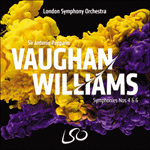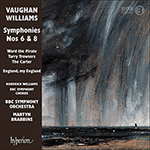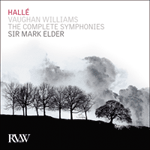
Welcome to Hyperion Records, a British classical label devoted to presenting high-quality recordings of music of all styles and from all periods from the twelfth century to the twenty-first.
Hyperion offers both CDs, and downloads in a number of formats. The site is also available in several languages.
Please use the dropdown buttons to set your preferred options, or use the checkbox to accept the defaults.

From our perspective of the third decade of the twenty-first century it may be difficult to imagine the impact the appearance of Vaughan Williams’s next symphony made at its first performance in 1948. To say it came as a shock would be an understatement; the work caused reactions approaching consternation in some quarters, for this—the first symphony by Vaughan Williams not to possess an obvious single-minded character throughout—was a totally unexpected statement from the now seventy-five-year-old composer.
Deryck Cooke, for example, wrote at the time: ‘I was no more able to applaud than at the end of Tchaikovsky’s Pathétique Symphony—less so, in fact, for this seemed to be an ultimate nihilism beyond Tchaikovsky’s conceiving: every drop of blood seemed frozen in one’s veins.’
He was referring to the symphony’s astounding last movement, the perceived nihilism of which was taken by many to be a reaction to the cataclysmic events of August 1945 when the recently developed atomic bomb had obliterated the Japanese cities Hiroshima and Nagasaki, forcing that country to admit the failure of the conflict it had begun almost four years earlier.
Such a view was understandable, but Vaughan Williams consistently denied it was the inspiration for his new symphony—indeed, such views angered him. The work is not merely a depiction of violence and its aftermath: it is surely a product of human experience from the viewpoint of greater human understanding, and remains—as do each of his symphonies, preceding and succeeding the sixth—a work of musical art, not a background score for an extended news film.
In the sixth symphony the main musical idea running virtually throughout is the dramatic juxtaposition, indeed the clash, of tonalities a semitone apart: E minor and F minor. Although adjacent, they have almost nothing in common, and—when heard together at the very beginning of the work—the clash drives the music in dramatic fashion: F minor strives upwards, straining to be free, yet is immediately brought back down to earth by a powerful E minor chord in the lower region of the orchestra.
This startling opening is highly original, but in presenting it Vaughan Williams poses a creative conundrum that demands serious and consistent attention if it is not to be treated as a throwaway gesture by a composer unconcerned with the deeper expressive qualities such drama can expose, convey and resolve. The consequences—musical and emotionally expressive—Vaughan Williams brings to bear on resolving this seemingly implacable conundrum lie at the heart of this masterpiece: marks of an undoubtedly great composer.
The symphony’s emotional impact remains perhaps its most immediate and lasting characteristic. Succeeding this fearful opening, each tonality straining for dominance—the effect as potent as that which begins his fourth symphony—Vaughan Williams eases the tension with a galumphing dance and (another contrast) the lyricism of an extended, typically English theme of pacification, whose tonal basis of B major/minor reinforces E minor as the symphony’s heart as well as being practically the exact opposite of F minor. But the battle is not so easily won: the initial clash cannot be so suddenly gainsaid—it is still there, in the background, waiting to return. If the ‘shape’ of this movement and its emotional expression are easy to follow, different though they be, the music continues on a larger scale with the juxtaposition of seemingly irreconcilable statements—irreconcilable in melody, tonality and emotional character—until a smothering low E minor wedge stamps on the music, somewhat grudgingly bringing this first movement to an uncertain end. This symphony is clearly far from over.
But where to turn? The almost complete tonal opposite: B flat minor, when a dragging figure, brief but not exhausted, and always falling to a persistent thrice-repeated note, indicates the work is certainly not at its end. The three-note rhythm gradually builds—often followed by a soft, unison string passage—and rises by degrees to a defiant insistence, obliterating in its raw power. It is not yet enough: the music falls again, as if collapsing with exhaustion, before the scherzo is upon us, spontaneously revivified in its upward reach.
The scherzo’s serious power is contrasted, as the composer wrote in his notes for the first performance, with ‘a trivial little tune, chiefly on the higher woodwind’. Seemingly unrelated ideas follow and are made to fight by a force stronger than any of them: raw, elemental, pagan almost, in a manic search for—what? The symphony heaves with strength, at times twice as slow, but it is insufficient—and the music suddenly recedes, leaving a solitary bass clarinet to fall and part the curtain to the epilogue.
Have all these efforts come to naught? Not quite. Despite the dynamics in the epilogue never rising above pianissimo, the inner life of the music is not entirely extinguished—even when appearing to be exhausted and at an end. Vaughan Williams’s expression is constant: we observe, but do not participate. The final pizzicato rhythmic figure, deep in cellos and double basses, is identical to that from the slow movement, a falling semitone marking the mediant of E major—and, enharmonically, also of F minor—and thereby acknowledging that which set the entire work in motion. The symphony’s organic life may have taken a battering, but it is not over yet, and we are left with our own thoughts.
The universal impact of this masterpiece was virtually immediate: Arturo Toscanini, invited to conduct in London, was keen to perform the symphony. Regrettably, indisposition intervened and he never actually conducted the work, although, as his manager wrote to the BBC, ‘he practically knows it’. Three months after Boult’s premiere, John Barbirolli introduced the symphony to the Cheltenham Festival, and during March 1949 gave five performances with The Hallé. Less than a year after the premiere, the symphony had been recorded twice—first in the United States, and, two days later, in Britain.
from notes by Robert Matthew-Walker © 2022
Dans la sixième symphonie, créée en 1948, la principale idée musicale, omniprésente ou presque, est la juxtaposition dramatique, en fait le conflit, de tonalités distantes d’un demi-ton—mi mineur et fa mineur. Tout en étant contiguës, elles n’ont presque rien en commun, et—lorsqu’on les entend ensemble au tout début de l’œuvre—le conflit mène la musique de façon dramatique: fa mineur s’efforce de monter, en tentant de se libérer, mais est immédiatement ramené sur terre par un puissant accord de mi mineur dans le grave de l’orchestre.
Ce début saisissant est très original, mais en le présentant Vaughan Williams pose une énigme créatrice qui exige une attention sérieuse et soutenue pour ne pas être traitée comme un geste désinvolte d’un compositeur indifférent aux caractéristiques expressives plus profondes qu’un tel drame peut exposer, traduire et résoudre. Les conséquences—musicales et émotionnellement expressives—que Vaughan Williams fait peser sur la résolution de cette énigme apparemment implacable sont au cœur de ce chef-d’œuvre: les marques d’un compositeur dont la grandeur est incontestable.
L’impact émotionnel reste peut-être la caractéristique la plus immédiate et durable de la symphonie. Après ce début effrayant, où chaque tonalité s’efforce de prendre le dessus—l’effet est aussi puissant que celui qui marque le début de sa Symphonie nº 4—Vaughan Williams réduit la tension avec une danse sautillante et (autre contraste) le lyrisme d’un long thème de pacification, typiquement anglais, dont la base tonale de si majeur/mineur renforce mi mineur comme cœur de la symphonie tout en se situant pratiquement à l’exact opposé de fa mineur. Mais la bataille n’est pas si facile à gagner: l’affrontement initial ne peut être aussi facilement démenti—il est toujours là, à l’arrière-plan, attendant de revenir. Si la «forme» de ce mouvement et son expression émotionnelle sont faciles à suivre, aussi différentes soient-elles, la musique poursuit son chemin avec la juxtaposition à grande échelle de formulations apparemment incompatibles—incompatibles en ce qui concerne la mélodie, la tonalité et le caractère émotionnel—jusqu’à ce qu’un passage étouffant dans le grave en mi mineur piétine la musique, menant avec une certaine réticence ce premier mouvement à un fin incertaine. Cette symphonie est manifestement loin d’être terminée.
Mais dans quelle direction se tourner? L’opposé tonal presque total: si bémol mineur, lorsqu’une figure traînante, brève mais pas exténuée, retombant toujours sur une note persistante répétée à trois reprises, indique que l’œuvre n’est certainement pas terminée. Le rythme de trois notes augmente peu à peu—souvent suivi d’un doux passage des cordes à l’unisson—et monte par degrés vers une insistance provocante, oblitérant dans sa puissance brute. Cela ne suffit pas encore: la musique retombe, comme si elle s’effondrait, épuisée, avant l’arrivée du scherzo, spontanément revivifié dans sa portée ascendante.
La puissance phénoménale du scherzo est contrastée—comme l’indiqua le compositeur dans son texte de présentation pour la première exécution—avec «un petit motif insignifiant, essentiellement aux bois aigus». Viennent ensuite des idées sans rapport apparent, contraintes à la lutte par une puissance supérieure à n’importe laquelle d’entre elles: brute, élémentaire, presque païenne, dans une recherche frénétique de quelque chose qui reste indéterminé. La symphonie se soulève avec force, parfois deux fois plus lentement, mais ça ne suffit pas—et la musique s’estompe soudain, laissant une clarinette basse solitaire baisser et lever le rideau sur l’épilogue. Tous ces efforts n’ont-ils abouti à rien? Pas tout à fait. Si la dynamique de l’épilogue ne dépasse jamais le pianissimo, la vie intérieure de la musique n’est pas totalement éteinte—même lorsqu’elle semble épuisée et à sa fin. L’expression de Vaughan Williams est constante: on observe, mais on ne participe pas. La figure rythmique pizzicato finale, dans le grave aux violoncelles et contrebasses, est identique à celle du mouvement lent, le demi-ton descendant marquant la médiante de mi majeur—et, enharmoniquement, aussi de fa mineur—et soulignant ainsi tout ce qui met l’ensemble de l’œuvre en mouvement. La vie organique de la symphonie en a peut-être pris un coup, mais elle n’est pas encore terminée, et nous sommes laissés à nos propres pensées.
L’impact universel de ce chef-d’œuvre fut presque immédiat: au mois de mars 1949, John Barbirolli en donna cinq exécutions avec le Hallé Orchestra. Moins d’un an après sa création, cette symphonie avait été enregistrée à deux reprises—tout d’abord aux États-Unis et, deux jours plus tard, en Grande-Bretagne.
extrait des notes rédigées par Robert Matthew-Walker © 2022
Français: Marie-Stella Pâris
Auch die 6. Sinfonie, uraufgeführt 1948, zeigt einen praktisch allgegenwärtigen Hauptgedanken. Es ist die dramatische Gegenüberstellung, ja Konfrontation zweier Tonarten, die nur einen Halbton voneinander entfernt sind: e-Moll und f-Moll. Trotz ihrer Nachbarschaft haben sie so gut wie nichts gemeinsam. Ihr Zusammenprall zu Beginn des Werks wird zur dramatischen Triebkraft der Musik: Das f-Moll strebt aufwärts, drängt nach Freiheit, wird aber sofort wieder nach unten gezogen durch den machtvollen e-Moll-Akkord aus den tiefen Lagen des Orchesters.
Mit dieser geradezu bestürzenden Eröffnung schafft Vaughan Williams eine beträchtliche schöpferische Fallhöhe: Soll sie keine bloß effektvolle Geste bleiben, deren dramatisch-expressivem Potenzial der Komponist keine weitere Beachtung schenkt, so verlangt sie eingehende und durchgängige Entwicklung. Im Zentrum dieses Meisterwerks steht Vaughan Williams’ Ausarbeitung der Folgen dieses scheinbar unversöhnlichen Konflikts in kompositorischer und emotional-expressiver Hinsicht—das Werk eines zweifelsfrei großen Komponisten.
Die vielleicht unmittelbarste und nachhaltigste Eigenheit der Sinfonie ist ihre emotionale Wucht. Nach dem Schock des Beginns, in dem beide Tonarten um die Vorherrschaft ringen—und der in seiner Wirkung dem der 4. Sinfonie gleichkommt—sorgt Vaughan Williams für Entspannung mit einem schwerfällig wiegenden Tanzthema; als weiterer Kontrast folgt ein friedvoll weitgespanntes, typisch englisches Thema. Sein tonales Zentrum H-Dur/h-Moll stärkt e-Moll als Haupttonart der Sinfonie; zugleich bildet es den genauen Gegensatz von f-Moll. Doch so leicht ist der Kampf nicht gewonnen: Der Zusammenprall vom Beginn lässt sich nicht einfach leugnen, er lauert im Hintergrund auf seine Wiederkehr. So fasslich die „Form“ des Satzes und sein Gefühlsgehalt—bei allen Kontrasten—auch sein mögen: Die Musik setzt in größerem Maßstab die Konfrontation scheinbar unversöhnlicher Aussagen fort—unversöhnlich in Melodik, Tonart und emotionalem Charakter—bis sich der tiefe e-Moll-Klang gleichsam erstickend über die Musik legt und diesen ersten Satz voller Ingrimm zu einem instabilen Ende führt. Diese Sinfonie, soviel ist sicher, ist noch keineswegs vorbei.
Doch wie kann es weitergehen? In der nahezu gänzlich gegensätzlichen Tonart b-Moll, in der eine schleppende Figur anzeigt, dass es noch nicht vorbei ist—eine Figur, die stets mit drei beharrlich wiederholten Tönen endet. Dieser Rhythmus, oft gefolgt von einer leisen Unisono-Formel der Streicher, wächst stufenweise und mit trotziger Beharrlichkeit zu vernichtender Macht an. Doch genug ist es noch immer nicht: Die Musik stürzt erneut, gleichsam erschöpft, in sich zusammen. Dann setzt, mit unvermittelt aufwärtsstrebender Energie, das Scherzo ein.
Dem grimmigen Drängen des Scherzos wird—in den Worten des Einführungstextes, den der Komponist zur Uraufführung schrieb—„eine kleine, triviale Melodie“ entgegengesetzt, „vor allem in den hohen Holzbläsern“. Es folgen Einfälle, die scheinbar nichts damit zu tun haben und doch gegen eine überlegene Kraft ankämpfen müssen: roh, elementar, beinahe heidnisch, und wie besessen auf der Suche—doch wonach? Die Sinfonie strotzt vor Kraft, zeitweise in halbem Tempo, aber das reicht alles nicht. Plötzlich zieht sich die Musik zurück, eine einsame Bassklarinette öffnet mit fallender Gebärde den Vorhang für den Epilog.
War alle Mühsal umsonst? Nicht ganz. Obwohl im Epilog die Dynamik nie über ein pianissimo hinausgeht, ist noch immer Leben in der Musik—selbst wenn sie wirkt, als sei sie erschöpft und am Ende ihrer Kräfte angelangt. Durchweg vermittelt sie: Wir beobachten das Geschehen, nehmen aber nicht daran teil. Die Pizzicato-Schlussgeste in der Tiefe von Celli und Kontrabässen ist identisch mit der aus dem langsamen Satz; ein fallender Halbtonschritt kennzeichnet die Mediante E-Dur—und ihre enharmonische Nachbarin f-Moll—und verweist damit auf den Konflikt, der das ganze Werk angestoßen hatte. Die Sinfonie mag gleichsam in ihrer Körperlichkeit verwundet sein, doch noch ist sie da—und wir sind unseren Gedanken überlassen.
Dieses Meisterwerk war sofort ein durchschlagender Erfolg. Allein im März 1949 dirigierte John Barbirolli fünf Aufführungen mit dem Hallé-Orchester. Kein ganzes Jahr nach der Premiere gab es bereits zwei Aufnahmen der Sinfonie—die erste in den USA, mit zwei Tagen Abstand gefolgt von der zweiten in Großbritannien.
aus dem Begleittext von Robert Matthew-Walker © 2022
Deutsch: Friedrich Sprondel
 Vaughan Williams: Symphonies Nos 4 & 6 Vaughan Williams: Symphonies Nos 4 & 6Sir Antonio Pappano leads the London Symphony Orchestra in a pair of symphonies by Ralph Vaughan Williams that span the build-up to and aftermath of the Second World War.» More |
 Vaughan Williams: Symphonies Nos 6 & 8 Vaughan Williams: Symphonies Nos 6 & 8‘Essential listening’ … ‘unequivocally excellent’: just two of the critical superlatives earned by Martyn Brabbins’s magnificent RVW symphony cycle. Here, two late symphonies are coupled with a rare choral work from World War II and three unpublis ...» More |
 Vaughan Williams: The Complete Symphonies Vaughan Williams: The Complete SymphoniesThe Hallé enjoyed a particularly rich relationship with Vaughan Williams in the last decade of the composer's life, and it is with a justifiable sense of pride that this new cycle of the nine symphonies comes with a host of pictures and recollecti ...» More |

